“Styles come and go. Good design is a language, not a style.” - Massimo Vignelli
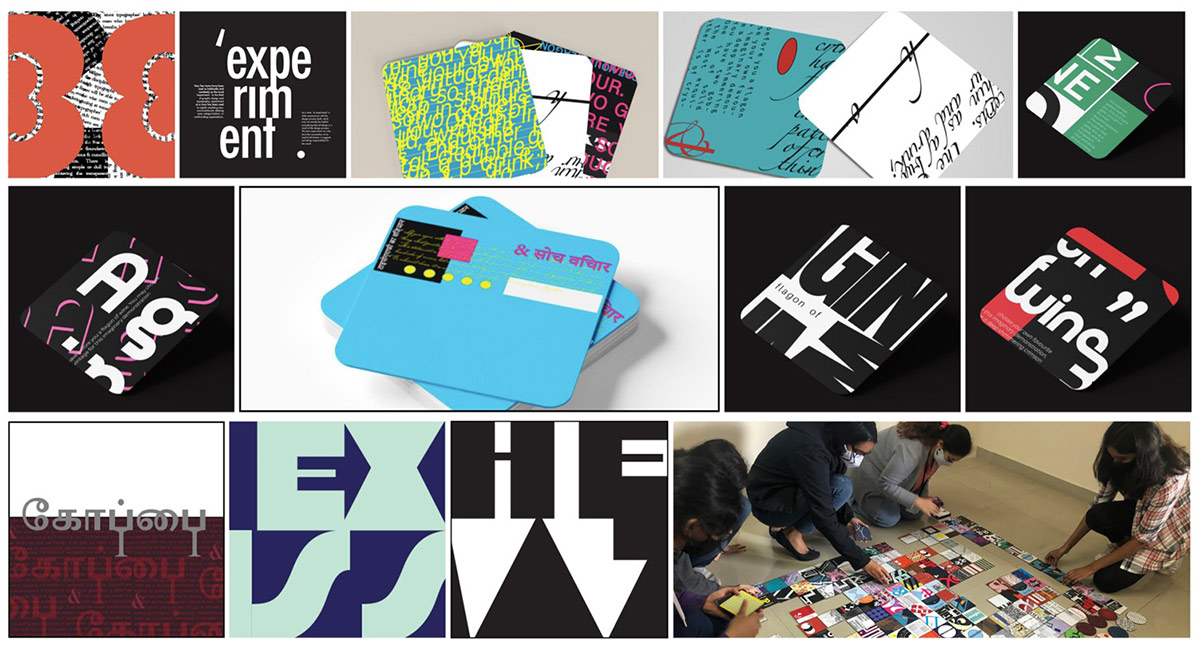
Students of VCSB display their work from Typography Studio.
Vision
Design is key to our economic growth and cultural evolution. A designer’s role involves both individual ingenuity as well as collaborative creativity. Designers can no longer function in isolation since today design is not just a creative and thoughtful activity but also a collaborative venture. In the Visual Communication and Strategic Branding course at the Srishti Manipal Institute, we also focus on educating our students to become engaged and socially aware professionals who become agents of change, engaged in activism and advocacy in the context of business, society, or environment.
This course is designed to address communication and marketing needs of variety of industry clusters across new as well as traditional mediums, materials, and platforms. Learning fundamental skills, design processes and conceptual thinking takes precedence over learning to use computer applications and software. Gaining wider historical and contextual perspectives, strategies and solutions, proficiency in communication and presentation skills, decoding and making meaningful forms and executing these forms and messages using various media are some of the objectives of this course.
We locate ourselves at the meeting point of business necessity and artistic value, where Integrity and personal expression of art meets the purposefulness of commerce supported by a genuine insight into people and the way they feel.
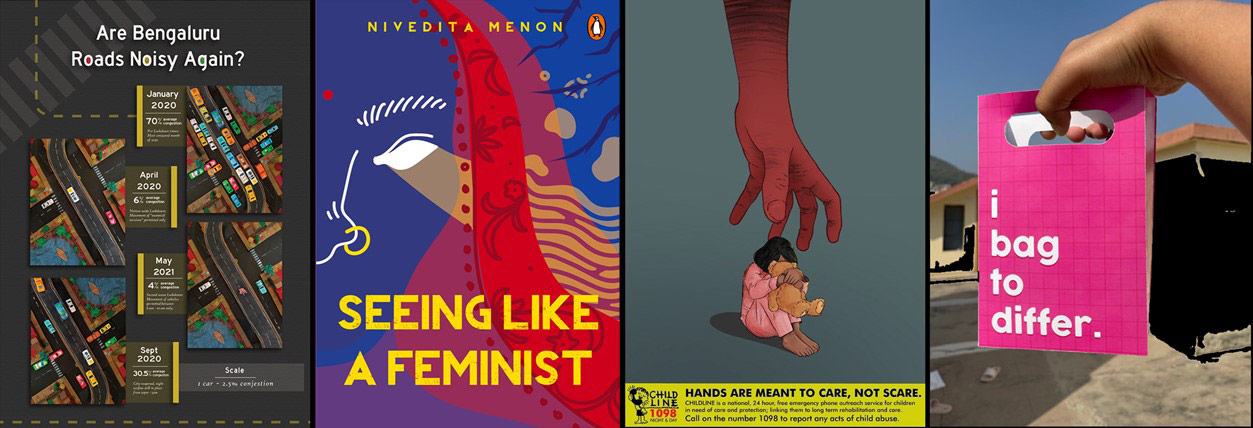
VCSB students’ work during Social Communication Studio.
Core Values
Purposefulness
Acknowledging Impact
Empathy
Critical Perspectives
Making & Doing
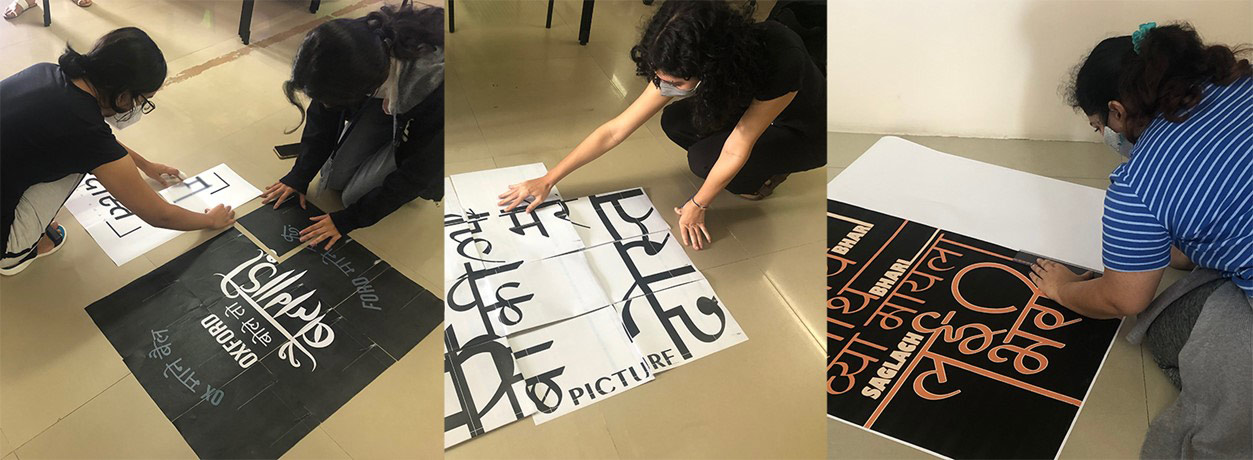
VCSB 2nd year students work on multi-lingual poster design.
Course Structure
The curriculum comprises of different ways of learning as follows:
- Foundation introduces students to basic principles and tools of Art, Design and Technology as methods, tools and processes. Read more >>
- Disciplinary Studios are learning spaces where students develop core disciplinary capabilities, while navigating a trans-disciplinary environment
- General Studies is a common and compulsory programme of study that integrates Humanities, Sciences, Maths, business and finance. Development and Policy Studies and also offers Languages (Spanish, French and German) Read more >>
- Interim is an immersive introduction to practice in new and emerging areas of art and design and environmental exposure
- Electives are of three kinds - this program allows students to expand their skills, develop the interests as well as provide opportunities for travel exchange
- Internship/Apprenticeship is compulsory work experience done over the summer-break between the 6th and 7th semester
- Project based learning involves the application and synthesis of capabilities acquired. Two projects, pre-thesis and thesis, is culmination of the 4-year undergraduate program, which allows for demonstration of an integration of values, positions, capabilities and practice. Read more >>

Work done during Branding and Identity Studio by Veetrag.
Learning Approach
The Visual communication & Strategic Branding course crosses a wide range of disciplines such as Branding, Publication Design, Photography, Social Communication, Illustration, User Interface Design, Information Design and Experience Design. This cross-fertilization provides a coherent conceptual base and insights that can work effectively to address rapidly changing global and local contexts.
Inputs from user-centric design and strategic design such as qualitative and quantitative research methods and various brand models will enable students to apply their learning in the context of visual communication and branding. Engagements with Typography, Font Design and Calligraphy will enable students to apply their learning in the context of print, publishing and marketing communication. Immersion in principles of interaction and interface design and information design will empower students to become familiar with digital medium and interactive platforms.
The curriculum approaches visual communication & strategic branding through theoretical frameworks combined with applied learning. This method not only informs and enhances the practice but also encourages students to question the norms and scale traditional boundaries.
Capability Sets
Upon successful completion of this course graduates will have developed the following capabilities:
- Be empathetic to users and stakeholders within larger contexts where the work is situated including environments, cultures, markets and societies.
- Understanding historical theory, contexts and finding roots to base work upon.
- Articulate in Visual Language using form, shape, color, composition, typography with acute attention to detail.
- Ability to think and work using metaphors, signs and symbols to enhance meaning and communication.
- Understand inherent nature of variety of printed and electronic media and use them effectively.
- Engaging in research with an inquiring mind, and methodical analysis to identify needs, generate insights and propose solutions.
- Develop critical thinking, problem solving ability, organising ability, to gain contextual perspectives.
- Develop lateral thinking ability to approach the unknown, crossing boundaries, and engage in multi-disciplinary ways.
- Work Collaboratively in Participative design, to learn from others and engage in joint creative effort.
- Demonstrate reflective & balanced practice while drawing upon personal experiences, values and theories to improve skills, approaches and knowledge.

Work done during Branding and Identity Studio by Veetrag.
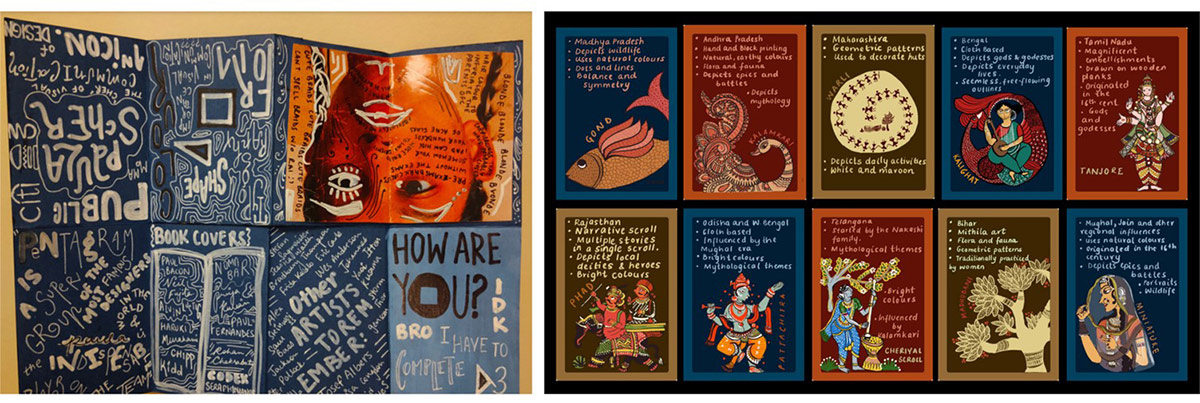
Students’ work during History & Identity Studio.
Opportunities
The above capability sets equip and prepare the student for a wide range of career opportunities with:
- Graphic Design Studios: As designer in a graphic design studio, start-ups, small and medium-size professional branding and marketing companies involved in a wide range of projects from conceptualization to execution.
- Designer in R&D Department of Corporations: Work as a designer and research associate to enhance company’s products, services, work on documentation, presentations, and marketing material for the company’s new initiatives.
- UX/UI Design: Junior to mid-level user interface and interaction designer in the creative department of an IT firm, to contribute at various stages of the creative or coding process.
- Advertising Firms: Junior to mid-level designer in the creative department of an advertising firm, to contribute at various stages of the creative process.
- Visual Communication Studios: As designer working on multiple aspects of visual communication in a variety of contexts; retail, exhibition, packaging, environmental graphics, digital interfaces and emerging overlaps with other disciplines.
- Publishing Houses: Content creation combined with image making and/or illustration, with a knowledge of publication design enables graduates to craft narratives and books different kinds of market.
- Independent Practice: As a contemporary visual designer, entrepreneur, and design consultant.
- Innovation Centres: As a design thinker, information designer and visual communicator.
- NGOs: Work in various NGO sectors from education to environment to increase awareness and inform social / political issues, Help in marketing and funding endeavours.
People
Enquiries

Disciplinary Intersections
The course is informed by the following learning disciplines:
Printmaking and Print Production
Illustration
Information Design
Design Research
Typography
Photography
New Humanities
Interface Design
Interaction Design
Service Design
History of Art and Design
Research and Collaboration
The focus areas in Visual Communication and Strategic Branding offers opportunities to connect with artists and designers from a range of research and practice labs and centres based at Srishti Manipal. These include:
Kabir Project
Blank Noise
Centre for Experimental Media Arts
Art in Transit
Impact Edge
The Writing Centre
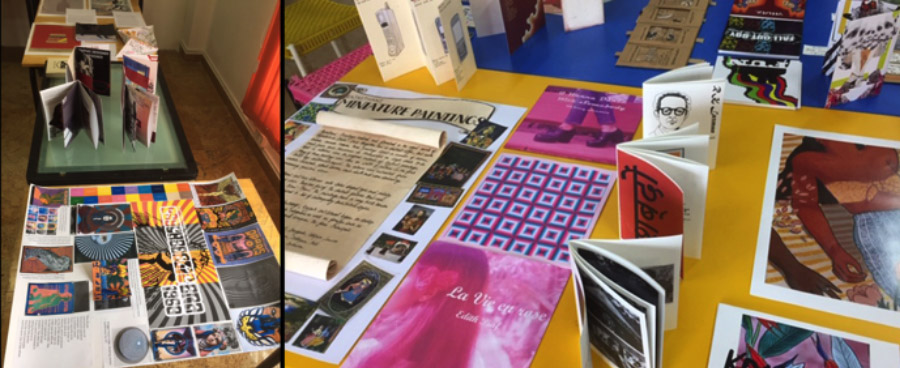
Studio work showcasing Historical Research.
FAQs
Visual Communication and Strategic Branding course provides a conceptual foundation for students to develop critical thinking skills in visual design. Objective of this course is to provide a broad-based curriculum that spans graphic design and strategic thinking so as to inform the learners about the practice of visual communication design, advertising and branding. Design is not an activity unto itself, it has to respond to marketing and communication needs of all the stakeholders including society, businesses and services. This course while being rooted in the traditional discipline of Visual Communication Design, also branches out to meet marketing and social communication needs by including Strategic Design and Design Thinking,
The curriculum is designed to introduce various systems of knowledge, and expertise in the discipline of Visual Communications Design, with a breadth of understanding of all related disciplines such as UX/UI design, Printmaking, Animation, Illustration, Photography, Visual Culture, and Social Communication. You will gain an understanding of the process of envisioning Visual Communication by engaging in coursework, studios and units spanning a variety of print and digital design projects. Interdisciplinary studies in arts and humanities are combined with learnings in visual form, typography, design history & theory, design research & processes, branding and advertising, illustration & visual narratives to provide students with intellectual tools and practical skills that empower and enrich you throughout your life and careers.
You will also learn methods of Representation, Interaction and Communication using Visual Tools, thus mastering traditional forms while keeping up with the new media.
Visual Communication and Strategic Branding is an academic mix of both these areas of practice. Under the choice-based navigation system of our curriculum there are opportunities for a student to focus on signing up for branding and strategy related units just as there are opportunities to focus on learning units for publication design and other print-based or digital design based units. However, completely separating the two may not be strictly possible.
The undergraduate programs at Srishti Manipal Institute encourage multi-disciplinarity and this is achieved through choice-based navigation systems. Students are required to declare their major area of study in their Foundation year but in year 2 and 3 they are encouraged to sign-up for learning units from other courses as their minor credits. Thus, a student with a major in Visual Communication and Strategic Branding could sign up for a unit from Digital Media Arts as a minor, and acquire some learning in animation and digital media, or vice versa.
The same holds good for those who wish to pursue a career in User Interface and Interaction Design but want to take Visual Communication as a major to gain a strong foundation in visual design and graphic design. Such a learner will be able to navigate his/her journey in the 2nd and 3rd year by balancing sign-up between units from Human Centred Design and Visual Communication Design.
Upon graduating with major in Visual Communication and Strategic Branding you will be able to pursue a career and a professional creative contributor in an advertising agency / a design studio / an NGO / Corporate Communications department of a multinational or domestic company / publishing house / IT industry, working on any one or multiple roles as: a Graphic designer, Brand designer, Packaging designer, Illustrator, Mobile app designer, Interactive designer, User experience designer, Publication designer, Exhibit/environmental designer, Design Researcher.
Yes, successful completion of any of our undergraduate professional courses make our graduates eligible to apply for Masters courses either at Srishti Manipal Institute or anywhere else in the world. Some of the courses offered by Srishti Manipal Institute’s M Des program will particularly enhance a candidate’s career options. Courses in Human Centered Design, Earth Education and Communication, Design Computation or Design-Led Innovation will help build upon your skills and apply their learning in these new contexts thereby expanding your practice and repertoire of capabilities.




